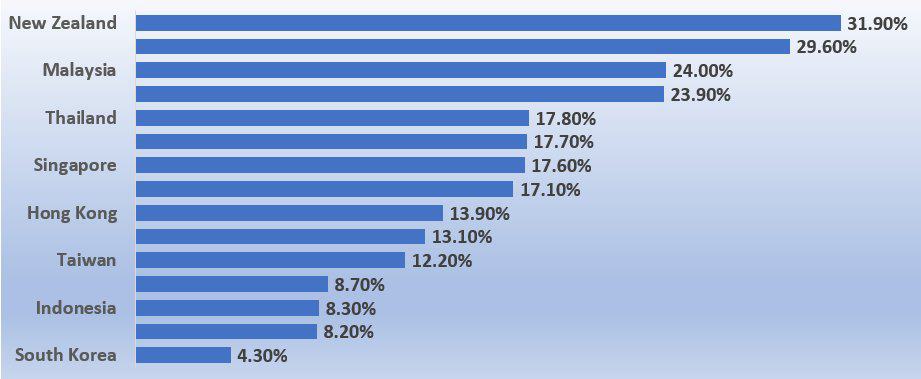According to the World Economic Forum’s Global Gender Gap Report 2022, it will take 132 years to close the global gender gap – up from 100 years pre-pandemic. What is happening here? The report noted that in East Asia and the Pacific, the region has closed 69% of its gender gap. However, the report that at “this pace, it will take 168 years to close the gender gap.”
The report acknowledges that more women have been moving into paid work and, increasingly, leadership positions. However, “globally societal expectations, employer policies, the legal environment and the availability of care continue to play an important role in the choice of educational tracks and career trajectories.”
Human Resources: an evolving discipline
Reflecting on her 25 years in the human resources function, Rohini Sachitanand, vice president of human resources for APAC, Japan and China at Hewlett Packard Enterprise (HPE) says she has witnessed some radical shifts that have moulded this practice to be prioritised as a core business function leading business decision and enabling profits.
“The post-pandemic phase has been dynamic, to say the least, with technology easing up manual processes and allowing work flexibility with hybrid models. HR practice has risen above managing hiring, exit, payroll to being highly business oriented – offering mentoring and coaching, to creating thought leaders,” she noted.
According to Melissa Kee, chief people officer at Temus, the HR function is used to focus on the operational, policy and compliance aspects of people matters. However, recent workforce trends have widened the scope and complexity of how HR can shape the workforce of the future.

“Today, Chief People Officers play the role of a strategic partner to achieve the desired impact on employee engagement, development, and performance for the business. This includes employee total well-being, realising strategic value from people data, and harnessing economic impact for the greater good.”
Melissa Kee
Obstacles to diversity and inclusion adoption
Sachitanand says there are not enough women taking up careers in STEM, and far fewer make it into leadership positions – at a time when related industries are facing a talent shortage. This, for her, presents a key obstacle to getting more women into key roles.

“Businesses are increasingly becoming more aware of this missed opportunity and are joining forces to bridge the gap,” she adds. “It will be important to identify the potential challenges women face when considering careers in STEM and seek ways to address these issues. Encouraging more young women to pursue STEM education careers will further the objective of creating a diverse and inclusive workforce.”
Homing in on the technology industry, Kee says the biggest challenge is in levelling the playing field for anyone who wishes to break into the tech industry, regardless of age, gender, academic credentials, or stage in life.
“A digital economy needs a growing pool of digital talent, and to do so while being truly inclusive is to provide maximum opportunities for everyone – even individuals from beyond the traditional supply streams of digital talent – to have a chance at a digital career,” she added.
UN call to arms for 2023
The International Women’s Day 2023 theme is DigitALL: Innovation and technology for gender equality suggest technology can and should be used as a tool to improve DEI. Asked for their take on this, Kee concedes that technology is among the most powerful tools in HR leaders’ arsenals.
“For example, data-driven AI can help organisations recruit the best employees for the role, based on skills, performance, and merit,” she adds. “The fast-evolving tech sector presents exciting opportunities for talented individuals from all backgrounds, women included, to thrive.
“By diffusing the concentration of any specific demographic, employers are encouraging diversity of thought – which is key to uncovering blind spots to drive further innovation,” opines Kee.
Within the HR function itself, Sachitanand says more and more HR teams are leveraging advanced technologies such as AI and automation to remove human biases in their hiring processes, with AI recruitment tools designed to source candidates from a variety of backgrounds.
“AI is also being used to ensure equal promotion opportunities by analysing employees’ skills and performance without unconscious bias, enabling more employees from minority groups to break through glass ceilings in the workplace,” she opines.
Most significant DEI initiative
According to Kee, Temus wants to attract the best talent to help organisations unlock value through holistic digital transformation. She cited the company’s “hire, place, train” tech career conversion programme – Step IT Up x Temus – which aims to level the playing field for talented homegrown individuals from non-tech backgrounds looking to enter a digital career.
“Reflecting on the evolution of our workforce, the ideal state is where diversity and inclusion become ingrained as culture, where people naturally interact with empathy for, and awareness of, our actions on others,” she points out.
Sachitanand says at HPE, people are the company’s greatest strength, and investing in culture is a key priority for its leadership.
“DEI is ingrained in who we are; we are continually striving to push for inclusion by providing a workplace where our people feel psychologically safe and know that their ideas are valued.,” reveals Sachitanand.

“We believe in fostering an unconditionally inclusive culture focusing on the diversity of thought, which means everyone in any conversation is an equal and contributes different perspectives and experiences for one common purpose – to advance the way people live and work. This is key to building an innovative, agile, and responsive organisation"
Rohini Sachitanand
Breaking the senior leadership glass door
“Stay curious, courageous, and authentic. Challenge yourself and don’t be afraid of failure,” suggests Kee. She also recommends proactively taking up leadership roles, no matter how small the team or project is.
Additional suggestions include taking credit for your good work and working with mentors who understand the challenges that women face in the workplace.
“Be confident in the unique value you bring to the table as a professional and seize opportunities to prove yourself. Remember: it is okay to walk alone if you are headed in the right direction,” she adds.
To advance their careers, Sachitanand often counsels women to focus on their strengths, rather than holding themselves back because of the perceived skills gap.
“I encourage them to be proactive and ask for bold and challenging roles. It is not enough to hope that others will recognise your achievements and hand you projects that will progress your career,” she opines.
The connection between DEI and ESG
Sachitanand says organisations need to address sustainability issues in a more holistic and integrated manner in a way that often requires a rethink of certain aspects of their business operations - such as product designs, supply chain, and community engagement.
“By bringing in diverse teams, organisations can benefit from a diverse set of experiences, perspectives, and backgrounds – something that has proven crucial for organisational innovation and the development of new ideas.
“To address the climate crisis, the world will need to move quickly and devise new approaches to how we’ve done things in the past. Diverse and innovative organisations will be more likely to solve such complex problems, create innovative ideas and improve ESG performance,” she concludes.
Kee believes that as sustainability strategies broaden beyond just environmental impact, the scopes overlap in some areas.
In the context of the environment, she notes that DEI helps organisations gain a holistic understanding of their impact on the surroundings, thus building better ESG strategies.
In terms of society, she says DEI drives the strategies for positive societal impact, such as anti-discrimination policies, thus helping the company avoid discriminatory pitfalls.
On the issue of governance, she voices out that being economically sustainable goes beyond the P&L. “DEI promotes transparency, empathy, and representation, leading to good governance - the heart of an organisation’s success,” comments Kee.
A place in the C-suite
The Deloitte Global Boardroom Program’s Women in the Boardroom report shows progress toward increasing the number of women on corporate boards, albeit slow progress. One interviewee FutureCIO spoke to on the topic described it as “glacial”.
Percentage of board seats held by women (by geography)

Kee believes that gender should not influence talent selection for internal advancement, mobility and access to highly visible, mission-critical roles, and experiences.
“Championing an inclusive workplace –– fair pay, flexible work arrangements, support for returning mothers –– and sponsorship from the top and mentoring by C-Suite women leaders are invaluable,” she opines.
She reiterates her view that mentorship provides an avenue for professional support, networking, learning, and opportunities for advancement. “This will also help women find role models who will inspire them to leap in their careers,” she goes on.
For her part, Sachitanand believes that there is no one-size-fits-all solution because the dimensions of diversity vary for different communities in Asia. She posits that the primary focus, however, should be on inclusion. There needs to be more allyship from male colleagues to advocate for and include women in business discussions.
“Organisations also need to ensure that they are involving female leaders in any selection process for leadership and C-Suite roles, both as candidates as well as part of the selection process,” concludes Sachitanand.





